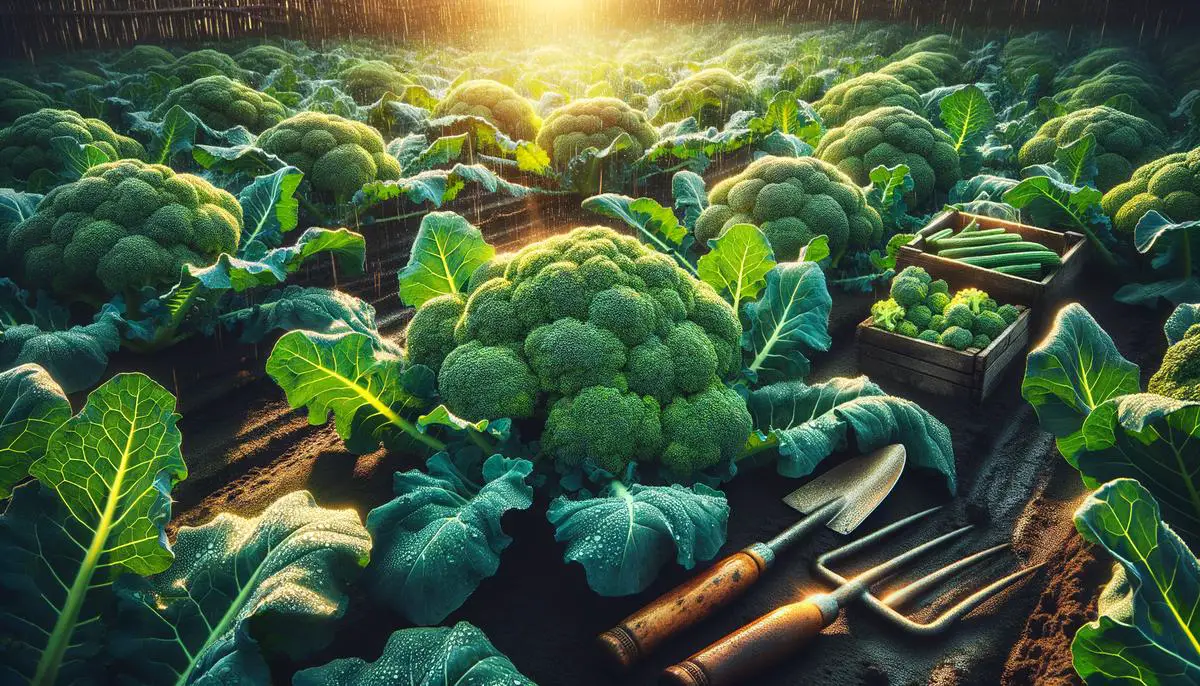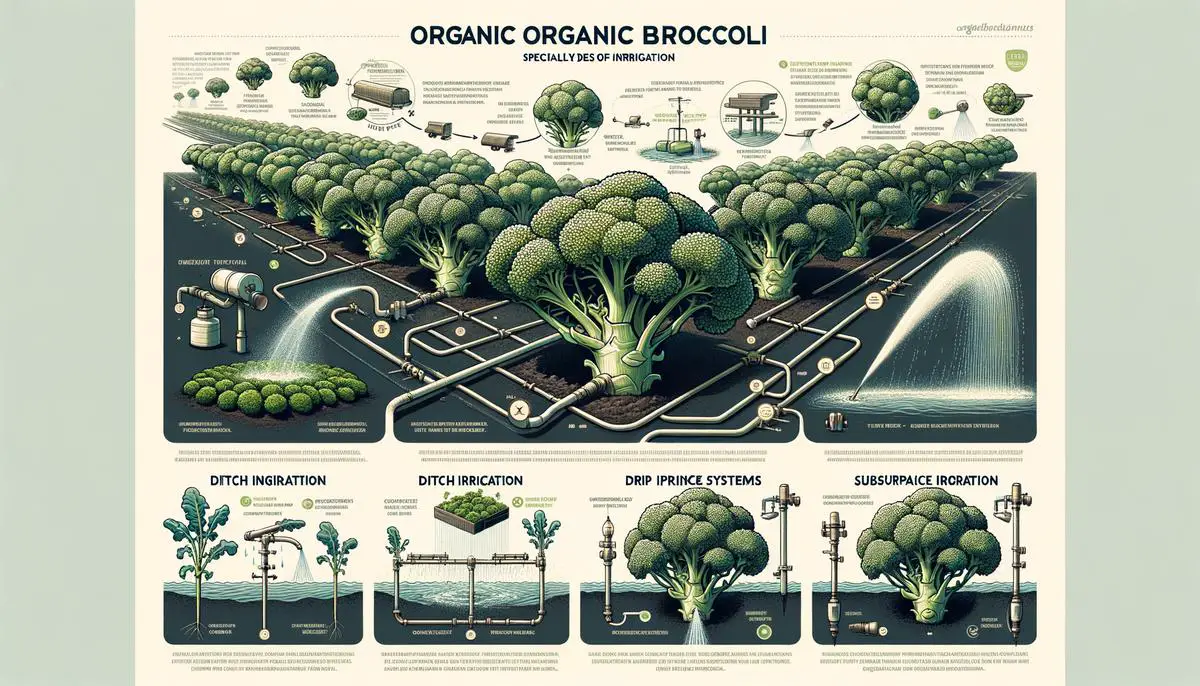Understanding Soil and Climate Conditions
Growing organic broccoli: the ideal soil and climate conditions
Organic broccoli thrives in cool weather and requires specific soil and climate conditions to grow successfully. Understanding these requirements is crucial for anyone looking to cultivate this nutritious vegetable organically. Let’s dive into the ideal soil and climate conditions that can help organic broccoli flourish.
Reader Poll: What online courses would interest you?
Soil Requirements
First and foremost, broccoli prefers well-drained, fertile soil rich in organic matter. The ideal pH level for the soil ranges from 6.0 to 7.0, which is slightly acidic to neutral. Before planting, it’s a good idea to test the soil’s pH and adjust it if necessary, using lime to raise the pH or sulfur to lower it. This ensures the soil provides the perfect environment for broccoli to absorb the necessary nutrients.
Incorporating compost or aged manure into the planting beds can significantly improve soil fertility and structure, encouraging robust broccoli growth. Given broccoli’s sensitivity to compacted soil, ensuring good drainage and aeration through organic matter addition can make a big difference in your crop’s success.
Climate Conditions
Broccoli is known for its preference for cool weather, making it an excellent crop for spring and fall. The ideal temperatures for growing organic broccoli range from 60°F to 70°F (15°C to 21°C). Temperatures above 75°F (24°C) can cause the plant to bolt or produce poor-quality heads, which is why timing your planting to take advantage of cooler temperatures is crucial.
Subscribe to our newsletter!
For spring crops, plant broccoli seeds indoors 6 to 8 weeks before the last expected frost date, then transplant them outdoors when the daytime temperatures consistently stay around 60°F. For a fall harvest, calculate backward from your first expected fall frost date to determine the best time to plant seeds directly in the garden or start indoors before transplanting.
Broccoli also requires consistent moisture for optimal growth, so regular watering is essential, especially in dry periods. Aim for about 1 to 1.5 inches of water per week, either from rainfall or irrigation, to encourage deep root development and prevent the heads from becoming tough.
Protection & Maintenance
To nurture your broccoli plants to maturity, consider using row covers to protect them from extreme temperatures and pests. Mulching around the plants can help maintain soil moisture, regulate soil temperature, and suppress weeds.
Considering broccoli’s nutrient demands, a balanced fertilizer can support healthy growth. However, since we’re focusing on organic broccoli, opt for organic fertilizers or compost to feed your plants. Keeping an eye on pests and diseases and using organic methods to manage any issues is also key to a successful harvest.
In summary, growing organic broccoli requires attention to soil fertility, pH level, adequate moisture, and cool growing temperatures. By creating the ideal growing conditions, you can enjoy a bountiful harvest of this healthy and versatile vegetable. Happy gardening!

Organic Pest and Disease Management
Managing pests and diseases organically in broccoli cultivation is an essential component of maintaining a healthy, productive garden without relying on synthetic chemicals. This approach focuses on prevention, cultural practices, and natural remedies to create a balanced ecosystem that supports the growth of broccoli while minimizing harm to the environment and beneficial organisms.
**Organic Pest Management in Broccoli
**- **Crop Rotation:** One of the simplest yet most effective strategies is to rotate crops annually. This practice prevents the build-up of pests and diseases that specifically target broccoli. By changing the location of your broccoli plants each year, you disrupt the life cycle of pests and reduce the chances of infestation.
- **Companion Planting:** Certain plants, when grown alongside broccoli, can naturally repel pests. For example, planting herbs like sage, dill, and rosemary near your broccoli can deter cabbage moths, while marigolds can repel nematodes and other pests. This method not only keeps pests at bay but also attracts beneficial insects to your garden.
- **Encouraging Beneficial Insects:** Beneficial insects, such as ladybugs, lacewings, and predatory wasps, play a crucial role in controlling pest populations. Attracting these allies to your garden can be as simple as planting flowering herbs and providing a habitat for them to thrive. These natural predators will help keep harmful pests in check.
- **Physical Barriers:** Floating row covers effectively protect broccoli plants from pests like aphids and flea beetles. By covering your crops with a lightweight, permeable fabric, you can prevent pests from reaching the plants while still allowing light and water to penetrate. Ensure the edges of the row covers are securely anchored to prevent pests from sneaking in.
- **Regular Monitoring and Hand Picking:** Regularly inspecting your broccoli plants enables early detection of pests. Hand picking pests like caterpillars and manually removing them from the plants can be a straightforward and immediate solution. Doing so regularly can significantly reduce pest populations.
Organic Disease Management in Broccoli
**- **Proper Plant Spacing:** Ensuring adequate spacing between broccoli plants improves air circulation, reducing the humidity that often leads to fungal diseases. Follow recommended spacing guidelines to prevent overcrowding and promote healthy growth.
- **Watering Practices:** Water your broccoli plants at the soil level rather than from above. Overhead watering can splash soil onto the leaves, spreading diseases. Drip irrigation or soaker hoses minimize this risk and keep the foliage dry, reducing the likelihood of fungal infections.
- **Healthy Soil:** A vibrant, biologically active soil is the foundation of disease resistance. Incorporating organic matter into the soil and practicing crop rotation enhances soil health, providing your broccoli with the nutrients and environment it needs to resist disease naturally.
- **Natural Fungicides and Bactericides:** In cases where disease does manage to take hold, consider using organic-approved fungicides and bactericides. Solutions such as copper sprays or baking soda mixtures can be effective against certain fungal diseases when used according to organic standards.
- **Removal of Infected Plants:** Promptly removing and properly disposing of any plants that are severely infected with pests or disease can prevent the spread to healthy plants. This step is crucial in maintaining the overall health of your garden.

Nutrient Management and Fertilization
Maintaining a thriving organic broccoli garden involves more than just meeting the plant’s basic needs. It demands a deep understanding of how to support the vegetable’s growth from the soil up, using natural resources and methods. Let’s explore some organic nutrient management strategies that are pivotal for healthy broccoli growth, beyond the foundational aspects already discussed.
One crucial step in ensuring your broccoli receives ample nutrition without resorting to synthetic fertilizers is to regularly test your soil’s nutrient levels. This can often be overlooked, yet it’s a linchpin practice in organic gardening. Soil tests illuminate specific deficiencies, allowing you to tailor your organic matter inputs precisely to your plants’ needs. For example, if your soil test reveals a low nitrogen level, which is critical for leafy greens like broccoli, you might consider adding organic fertilizers such as cottonseed meal or feather meal to boost nitrogen organically.
Another effective strategy is to harness the power of green manures and cover crops. These are plants grown not for harvest, but to be turned back into the soil, thereby improving its structure and fertility. Leguminous cover crops, such as clover or vetch, are particularly beneficial for broccoli as they fix atmospheric nitrogen into the soil, enriching it naturally. Planting these cover crops during your garden’s off-season not only protects against erosion but also ensures that once tilled into the soil, they act as a slow-release fertilizer for your next broccoli crop.
Incorporation of mycorrhizal fungi into the soil is yet another innovative approach. These beneficial fungi form symbiotic relationships with the roots of most plant species, including broccoli, facilitating better water and nutrient uptake. By improving the plant’s ability to access soil nutrients, they can significantly bolster broccoli’s growth and resilience against stress and diseases.
Composting remains a cornerstone method for enriching soil organically. However, advancing beyond basic composting involves creating a balanced compost tea, which can act as a powerful liquid fertilizer and soil conditioner. Brewing compost tea involves steeping well-aged compost in water to extract beneficial microorganisms and nutrients. When applied to the soil or directly on broccoli leaves, compost tea can provide a quick nutrient boost and help suppress foliar diseases through the action of beneficial microbes.
An often-underutilized strategy in organic broccoli cultivation is the practice of chop-and-drop mulching. This involves cutting down green plant material, such as cover crops or unwanted weeds, and leaving them on the soil surface as mulch. This method not only suppresses weeds and maintains soil moisture but also allows nutrients to return directly to the soil as the plant matter decomposes, creating a natural, nutrient-rich mulch that feeds the soil and, by extension, your broccoli plants.
Each of these strategies, from soil testing and the use of green manures to the introduction of mycorrhizal fungi, compost tea application, and chop-and-drop mulching, contributes to creating a rich, vibrant soil ecosystem. This ecosystem supports the complex nutrient needs of broccoli, ensuring that the vegetables grow healthy, strong, and nutritious without reliance on synthetic inputs. Engaging in these practices creates not only a thriving garden but also contributes to a more sustainable and ecologically friendly gardening approach, emblematic of the broader principles of organic farming.

Irrigation Techniques for Broccoli
Now, let’s dive into the most effective irrigation methods for maintaining the health and productivity of your organic broccoli. Understanding the right watering techniques is critical for the success of your organic garden, especially when it comes to moisture-loving crops like broccoli.
The first method worth considering is drip irrigation. This system allows water to slowly drip to the roots of the plants, ensuring that every drop is utilized efficiently. Drip irrigation reduces water waste, decreases the chances of soil erosion, and helps keep leaves dry, thus minimizing the risk of diseases. By delivering water directly to the base of the broccoli plants, you ensure that the roots receive the moisture they need without oversaturating the soil.
Another effective irrigation technique is the soaker hose system. Similar to drip irrigation, soaker hoses lay on the ground and allow water to permeate through tiny pores directly to the soil and roots beneath. This method is perfect for organic broccoli as it provides a gentle and consistent water supply, promoting healthy growth without disturbing the soil structure or compacting the soil—a concern for the sensitive root systems of broccoli.
For those who prefer a bit more control or have smaller gardens, hand watering can also be effective, especially when done carefully and thoughtfully. The key here is to water the base of the plants rather than the foliage, mimicking nature’s way of providing moisture through rain that soaks into the ground. This method requires patience and time but can be very meditative and connecting, offering you a chance to inspect your plants closely for any signs of stress or disease.
Whichever method you choose, it’s important to remember that the timing of watering can greatly impact the health of your organic broccoli. Early morning is the best time to water your plants, as it gives the water a chance to soak deep into the soil before the heat of the day can cause evaporation. Additionally, this reduces the risk of moisture-related diseases since the plants have time to dry off before the cooler, damp evening sets in.
Implementing an effective irrigation schedule is key to the successful growth of your organic broccoli. While each garden is unique and may require adjustments to the watering frequency, a general rule is to provide broccoli with 1 to 1.5 inches of water per week. Monitoring the soil moisture close to the roots can help you determine when additional watering is necessary. Be cautious not to overwater, as too much moisture can lead to root rot and other diseases.
By choosing and properly implementing the right irrigation method for your organic broccoli, you’re not only ensuring the health and productivity of your crop but also contributing to water conservation and the overall sustainability of your garden. Whether through drip irrigation, soaker hoses, or careful hand watering, the goal is to maintain a consistent moisture level that meets the needs of your broccoli plants without wasting resources. This mindful approach to watering supports the philosophy of organic gardening, promoting harmony between the garden and the natural environment.

Harvesting and Post-harvest Handling
Now, let’s dive into the crucial stages of harvesting and handling organic broccoli post-harvest to ensure we maintain its quality and extend its freshness.
Harvesting Organic Broccoli
The right time to harvest broccoli is when the flower heads are fully developed but before the flowers start to bloom. The heads should be dark green with tightly packed florets. This stage indicates the broccoli is ripe and at its peak for nutritional value and taste. If you see yellow petals starting to show, it means the broccoli is overripe – a common mistake to avoid.
Use a sharp knife to cut the broccoli stem about five inches below the head. It’s essential to make a clean cut to prevent any disease from entering the plant. Early morning is the best time to harvest, as the heads are cool and crisp. This timing also helps in reducing post-harvest field heat.
After Harvest Handling
Once you’ve harvested your organic broccoli, the immediate next step is cooling it down. This process is vital as it stops the enzyme action that can cause the broccoli to degrade and lose quality. You can achieve this by immersing the harvested broccoli in cold water or using a cold room if available. This step is crucial for extending the shelf life of broccoli, especially important for organic produce that doesn’t rely on chemical preservatives.
After cooling, gently pat the broccoli dry. This removal of excess moisture is pivotal to prevent mold growth during storage. Once dry, you can store your broccoli in the refrigerator. Optimal storage conditions include a cold and humid environment. Your refrigerator’s vegetable crisper is an ideal spot, providing the cold, slightly humid environment broccoli enjoys. For best quality, consume the broccoli within 5-7 days of harvest.
Packaging and Storage
For those looking to market organic broccoli, consider packaging that allows the produce to “breathe.” Perforated plastic bags are a popular choice, providing the necessary airflow. When packing, ensure the broccoli isn’t packed too tightly. Overcrowding can lead to moisture build-up, promoting decay.
It’s vital to understand that organic broccoli, like all organic produce, is more susceptible to bruising and damage without the protective chemical treatments conventional produce may receive. Handle it gently, whether you’re packaging for sale or just moving it to storage.
Remember, by focusing on the holistic approach that starts with soil preparation and ends with proper post-harvest practices, you can successfully grow, harvest, and enjoy organic broccoli. This vegetable not only enhances your meals with its rich, green color and crunchy texture but also contributes significantly to a healthy diet, all the more rewarding when you’ve managed its journey from soil to plate with your own hands.


